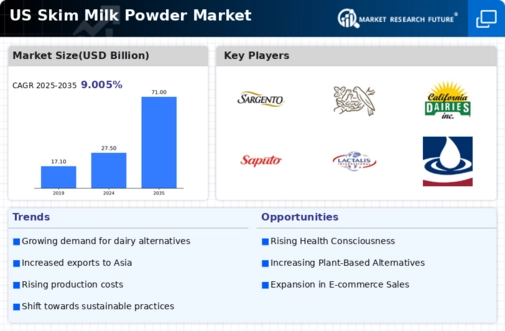Growing Export Opportunities
The skim milk-powder market is poised to benefit from expanding export opportunities. The US is one of the leading producers of dairy products, and the demand for skim milk powder in international markets is on the rise. In 2025, US exports of skim milk powder are projected to reach $1.5 billion, driven by increasing demand from countries in Asia and the Middle East. This trend suggests that the skim milk-powder market could see significant growth as producers capitalize on these international opportunities. By enhancing export strategies and ensuring compliance with international standards, the industry may strengthen its position in the global market.
Increased Use in Food Processing
The skim milk-powder market is experiencing growth due to its extensive application in food processing. Skim milk powder is utilized in a variety of products, including baked goods, sauces, and dairy-based snacks. The food processing sector in the US is expected to grow at a CAGR of around 3.5% from 2025 to 2030, which could drive demand for skim milk powder as a functional ingredient. Its ability to enhance texture, flavor, and nutritional value makes it a preferred choice among food manufacturers. Consequently, the skim milk-powder market stands to benefit from this trend as food processors increasingly seek high-quality ingredients.
Nutritional Fortification Trends
The trend towards nutritional fortification in food products is impacting the skim milk-powder market. As consumers become more health-conscious, there is a growing demand for products that offer enhanced nutritional benefits. Skim milk powder is often fortified with vitamins and minerals, making it an attractive ingredient for manufacturers aiming to meet these consumer demands. The nutritional supplement market in the US is projected to grow by 5% annually, which may positively influence the skim milk-powder market as it aligns with the trend of incorporating fortified ingredients into everyday foods. This alignment could lead to increased sales and market penetration.
Rising Demand for Dairy Alternatives
The increasing consumer preference for dairy alternatives is influencing the skim milk-powder market. As more individuals adopt lactose-free diets or seek plant-based options, the demand for skim milk powder, which serves as a versatile ingredient in various food products, is likely to rise. In 2025, the market for dairy alternatives in the US is projected to reach approximately $30 billion, indicating a shift in consumer behavior. This trend may lead to a greater incorporation of skim milk powder in formulations aimed at health-conscious consumers, thereby enhancing its relevance in the market. The skim milk-powder market must adapt to these changing preferences to maintain competitiveness.
Sustainability Initiatives in Dairy Production
Sustainability initiatives within the dairy sector are increasingly shaping the skim milk-powder market. As consumers become more environmentally conscious, there is a push for sustainable practices in dairy farming and production. The skim milk-powder market is likely to benefit from these initiatives, as producers adopt eco-friendly methods to reduce their carbon footprint. In 2025, it is estimated that 40% of consumers will prioritize sustainability when making purchasing decisions. This shift may encourage manufacturers to promote their sustainable practices, thereby enhancing the appeal of skim milk powder as a responsible choice for consumers.























Leave a Comment